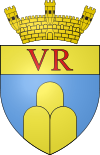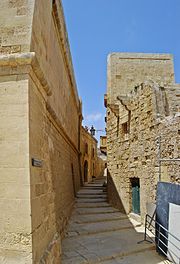Victoria (Malta)
| coat of arms | map |
|---|---|

|
|
| Basic data | |
| State : | Malta |
| Gzejjer : | Gozo and Comino |
| Distretti : | Gozo and Comino |
| Area : | 2,898,555 km² |
| Residents : | 6436 (December 31, 2018) |
| Population density : | 2220 inhabitants / km² |
| ISO 3166-2 : | MT-45 |
| Website : | www.victoria.org.mt |
| politics | |
| Mayor : | Samuel Azzopardi ( PN ) |
Coordinates: 36 ° 3 ′ N , 14 ° 15 ′ E
Victoria (also: Victoria Rabat , officially Maltese Ir-Rabat Għawdex ) is the capital of the Maltese island of Gozo with 6436 inhabitants (as of December 31, 2018). The city used to have the Arabic name Rabat , which means something like "suburb" (not to be confused with Rabat near Mdina on the main island of Malta). In 1897 Queen Victoria celebrated her diamond jubilee and the city name was changed at the request of the Bishop of Gozo Pietro Pace. Victoria is located in the center of Gozo, comprises just under a quarter of the island's population, making it the most populous city on the island. The residents are called Rabtin t'Għawdex or Vittorjani . Victoria is also the center of life on the island and its cultural center.
history
According to archaeological finds, the area was inhabited as early as the Bronze Age. In the 3rd century BC The Romans built a settlement on this site. From 535 to 870 the place belonged to the Byzantine Empire . During the Arab occupation (until 1127) the settlement was named Rabat . At that time, it essentially consisted of a citadel , where Gozo's residents could take shelter from pirate attacks . Nevertheless, in July 1551 almost the entire population of Gozo and Rabat was captured by slave hunters and brought to the slave markets of North Africa. The settlement remained largely uninhabited in the following years. In 1599 the reconstruction of the citadel began, which all Gozo residents then had to visit at night. After the abolition of this law in 1637, the citadel remained mostly uninhabited. In 1693 large parts of the citadel and Rabats were destroyed by an earthquake.
During the short existence of the state of Gozo , Rabat was its capital. In 1814 Malta and Gozo came under British rule. In 1864 Gozo became an independent diocese with Rabat as the seat of the bishop. In 1887, on Queen Victoria's Golden Jubilee , the bishop and a senior judicial officer of Gozo applied for Rabat to be renamed Victoria. With this they linked the request for city rights. On June 10, 1887, the governor of Malta granted these requests and the municipality of Rabat became the city of Victoria. In everyday parlance, the Gozo residents use the original name to this day. The double name Victoria / Rabat also comes in the emblem by the letters V and R expression, but also on V ICTORIA R Egina , ie Queen Victoria might indicate.
population
In ancient and medieval times, the area around today's Victoria was continuously inhabited by 1700 to 2000 people. In the late Middle Ages the population began to increase, especially in Rabat.
By 1530 there were more than 5,000 residents around the citadel. The enslavement of a large part of the population in 1551 then led to a slump from which Gozo and Rabat did not recover for a long time. Reliable census data on the number of residents in Rabat / Victoria have been available since 1667 .
After the setback in 1551, the number of inhabitants rose continuously, interrupted only by the decade after 1957, when a larger wave of emigration caused the number to drop again.
|
Victoria’s population development
|
|||||||||
|---|---|---|---|---|---|---|---|---|---|
| year | 1667 | 1842 | 1901 | 1948 | 1957 | 1967 | 1985 | 1995 | |
| Residents | 1795 | 4904 | 5057 | 6175 | 6357 | 5462 | 5968 | 6524 | |
| Percent d. Pop. Gozos | 43 | 34 | 25th | 22nd | 23 | 21st | 23 | 22.5 | |
Buildings (selection)
citadel
The heart of the city is the citadel, which was fortified in the Bronze Age, around 1500 BC. It was restored between 1599 and 1603 in order to better protect the city from corsairs and Muslims. From the fortifications you have a wonderful view over the island. In the citadel there is a museum as well as Gozo's cathedral and the courthouse.
Churches
- cathedral
- The Cathedral of Santa Marija (built from 1697 to designs by the Maltese Baroque master builder Lorenzo Gafà ) is the main church of the Diocese of Gozo and Comino and is located within the citadel. It is ornately decorated, including a statue of Mary to whom the church is dedicated. A Roman temple dedicated to Jupiter previously stood on the same site . In the church there is a trompe l'œil painting on the ceiling , which shows the inside of a dome , which was never built.
- Basilica of San Basilorġ
- The baroque basilica San Ġorġ of St. George , on the Pjazza San Ġorġ south of the market square, dates from the Middle Ages . In 1818 it was given a new facade and was elevated to a basilica by Pope Pius XII in 1958 . This basilica is also known as the golden church . It is completely covered with marble. It is richly decorated with paintings and statues and is located in the square of the same name.
- Church of St. John
- This place of worship , in Maltese 'Ta San Gabku' , stands on the edge of Independence Square ( Pjazza Indipendenza ). In front of it are a statue of the Madonna and a sculpture for Archbishop Saverjo Cassar (1746–1805).
market
The market square, called it-Tokk by the locals , is at the foot of the citadel on Pjazza Indipendenza ; every day there is a market there until noon . There is also a memorial to the soldiers from Gozo who fell in World War II and who served in the British Army. Behind it is the headquarters of the Maltese Workers' Party for the Gozo and Comino area.
Villa Rundle Garden
Villa Rundle Garden is a park in central Victoria that opened around 1914. The city park was designed by the English governor Leslie Rundle . There are many native and imported plants in the garden. It was reopened in May 2012 after extensive renovation work that cost around 2.5 million euros and 85 percent of which was funded by the European Union .
Cultural buildings
- The Teatru Astra was founded in January 1968. It fell into flames on November 8, 2003 and reopened in 2005. The house is on 9 Republic Street. It is maintained by the Soċjetà Filarmonika La Stella . She is also the sponsor of the La Stella music band and organizes the patronage festival of the Basilica of San Ġorġ Il-Festa ta 'San Ġorġ .
- Aurora Opera House at 100 Republic Street is in a 19th-century mansion that was remodeled in 1971-76. The house can accommodate up to 1600 visitors.
The narrowest street in Malta in the center is also worth mentioning .
Town twinning
Victoria is twinned with the Italian city of Nichelino in the metropolitan city of Turin in the Piedmont region .
Sons and daughters
- Alfred Xuereb (* 1958), Catholic clergyman, archbishop and diplomat, former papal secretary
Web links
- Official site of the city
- The Citadel on Gozo's official website
- Victoria and Citadel view
- Internet presence of the Soċjetà Filarmonika La Stella







